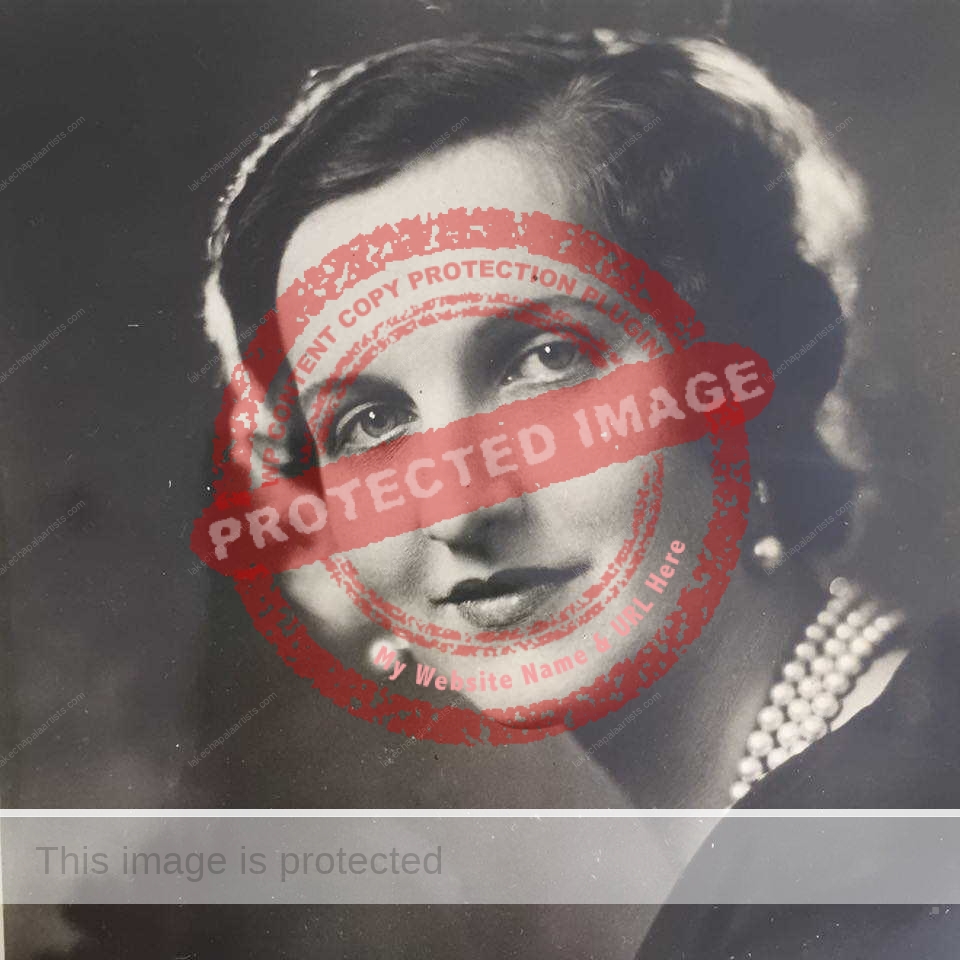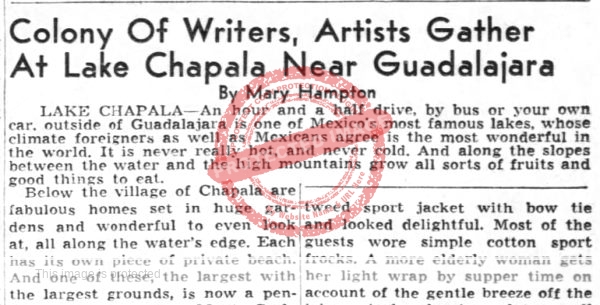Of the many journalists who have reported on Lake Chapala over the years, one of those with the most distinctive individual viewpoint was Mary Hampton, a long-time fashion editor based in California.

Mary Hampton. Credit: Ancestry.com
Born on 14 September 1899 in Nogales, Arizona (at a time when there was no border wall separating the town from Nogales, Sonora), Mary McDuffie Hampton traveled extensively before she began her 30-year career as a writer while still in college. Her first formal position, in about 1923, was with the San Francisco Chronicle, overseeing a children’s page using the pen name “Aunt Dolly.” It was in 1923 when Hampton married UK-born Edward L Leonard (1894-1975) in San Francisco; the couple subsequently had two daughters, Denise and Barbara, born in 1924 and 1926 respectively.
Hampton was one of the first female reporters at the San Francisco Chronicle, and quickly became the paper’s fashion reporter. She continued in that role, writing under the pseudonym Ninon, for more than a decade and established herself as California’s top fashion authority. In 1937, now divorced, she left the San Francisco Chronicle to start a daily column for The Modesto Bee. Now writing using her own name, she was an independent syndicated columnist, with her writing appearing for more than two decades in numerous California newspapers.
It was during her period writing as an independent columnist that she made several visits to Lake Chapala and other parts of Mexico. Her first report from the lake, in the first half of 1949, was titled “Mexico Loves Lake Chapala As We Do Our Lake Tahoe.”
Below the village of Chapala are fabulous homes set in huge gardens and wonderful to even look at—all along the water’s edge. Each has its own piece of private beach. And one of these—the largest with the largest grounds is now a Pension. And it here at Monte Carlo that I am luxuriating. My tall French windows open to a little balcony with a thick stone balustrade. And I look through towering palms over the garden to the lake whose gentle lapping puts me to sleep at night.”
She was taken with the fashion sense of the owner:
Señor Hermosillo, who owns this place and is a blond aristocrat from old Spain in former generations, dresses as if he were on the Riviera for supper. Last night he wore white flannels and a dark brown tweed sport jacket with bow tie and looked delightful.”
At the Villa Montecarlo, dining—year-round—was on a tiled veranda, with lunch served from 1.30 to 3.30, and supper from 8.00 to 9.00.
Hampton, noting that the area had “a growing colony of writers and artists,” met ‘Dane Chandos’ (Peter Lilley) and was invited to visit him at his home in San Antonio Tlayacapan. [Dane Chandos was the pen name used by Lilley, in partnership first with Nigel Millett and then with Anthony Stansfeld, for Village in the Sun and House in the Sun.]
She also wrote a lengthy column at this time about fashion and country club life in Guadalajara, noting that the city’s women “are noted for their beauty and it is no exaggeration,” and that she saw “young women by the dozen each more beautiful than our movie stars.”

In a separate column, Hampton described how she took a boat ride one morning to Ajijic to visit Neill James:
Ajijic is truly a Village in the Sun, a cluster of adobe houses near the lake’s edge with a little plaza and church. Since the Indians fear the air from the water at night, the land along the beach itself was conveniently left for the many writers, artists, and zestful mortals who have quietly trickled into Ajijic and built sprawly Shangri-La houses for themselves. Some are smaller like the casa of writer Neill James.”
Given her knowledge of fashion, it is no surprise that Hampton reported on how Neill James was teaching villagers how to make “beautiful little tailored blouses,” as “a hobby between herself and the Indians whom she loves.” Neill James herself was wearing “navy slacks, huaraches and a plaid cotton shirt. Her curly hair is unruly and her brown eyes warm and zestful.”
Four years later, in 1953, Hampton wrote a column titled “Mexican Resort is Scenic Spot,” in which she explained that “Chapala is bulging with Americans,” and that “it is almost impossible to rent any more,” despite the fact that “The lake’s edge has receded from the fabulous stone piers and jetties which once edged the beaches in front of the hotel-size homes surrounded by park gardens.”
Hampton also announced plans for a month-long summer vacation writers’ workshop later that year at the Villa Montecarlo. Besides herself, the instructors were Dane Chandos (“the brilliant English author who lives just beyond Chapala and whose books made nearby Ajijic famous”) and short story author A. Marshall Harbinson, a long-time instructor in English at the University of California. The workshop consisted of afternoon classes five days a week and a weekly round table discussion with Dane Chandos. An optional post-conference tour included visits to Pátzcuaro, Janitzio, Morelia, Mexico City, Taxco, Hacienda Vista Hermosa and Puebla. The workshop (or conference as it was called elsewhere) attracted writers “from many Bay area cities as well as Southern California.
Attendees were entertained at the homes of Neill James, Peter Lilley and Walter Schnaider (“the American millionaire who makes his home at Chapala”). In addition, “young Berkeley author” Willard Marsh, then living in Ajijic, gets a passing mention.
Hampton wrote two more interesting reports on Chapala during a visit in 1955. In between comments about the fashion choices of Mexican and American residents and visitors, she writes about:
the muchly advertised Ajicjic [sic] which this winter is causing something of a road congestion and human aggravation. Book in hand (they say they paid $2 for it) tourists come seeking Paradise for a dollar a day and don’t find it. Paradise is here for those who know the password but inflation has come to Mexico also—a sort of spillover from our own amazing affairs—and the pesos won’t buy quite everything.”
In a second piece, titled “Parties are an epidemic in the US Colony in Mexico,” Hampton lamented the fact that:
The Americans here are forever giving parties. They talk parties, some live for the parties; a few sigh wearily over the monotony of so much….
In the village of Chapala are all sorts of Taxco-like houses–Mexican versions of Carmel picturesqueness and many of these the Americans have now taken over. The decoration at times is daringly modern and always brilliantly interesting. As in Carmel, writers and painters gravitate this way. But it really began after Dane Chandos published “Village in the Sun”. Today the adjoining and famous village of Ajijic seethes with artists and pseudo-artists and would-be hangers-on, while a colony of well over 200 retired officers and doctors are finding a sun-drenched haven Chapala way. It is these, the members of the colony, who fill their nights with parties.”
By then, according to another US journalist, Vida Shepard (who spent several winters at Lake Chapala in the 1950s), Hampton had built herself a casita somewhere near the Capilla de Lourdes, on the hillside overlooking the Villa Montecarlo.
After retiring from journalism in January 1958, Hampton sold houses for a time in Apple Valley, gained a masters degree in English, and taught in public schools and at the University of Redlands. In the 1960s she also worked on a radio program for the elderly.
Mary Hampton lived her final years in Riverside, California, where she died at the age of 87 on 11 May 1987.
Several chapters of Foreign Footprints in Ajijic: Decades of Change in a Mexican Village offer more details about the history of the literary community in Ajijic. The history of the Villa Montecarlo is told in chapter 28 of If Walls Could Talk: Chapala’s Historic Buildings and Their Former Occupants (translated into Spanish as Si las paredes hablaran: Edificios históricos de Chapala y sus antiguos ocupantes).
Sources
- Berkeley Daily Gazette: 21 May 1949; 31 May 1949, 6; 30 April 1953; 22 July 1953; 26 Jan 1955.
- Riverside Daily Press: 25 May 1949.
- The Chico Enterprise Record: 28 Jan 1955.
- The Fresno Bee: 28 Jan 1955.
- The Modesto Bee: 24 Apr 1937, 9.
- Times-Advocate (Escondido, California): 13 May 1987, 26.
Comments, corrections and additional material are welcome, whether via the comments feature or email.
Tony Burton’s books include “Lake Chapala: A Postcard History” (2022), “Foreign Footprints in Ajijic” (2022), “If Walls Could Talk: Chapala’s historic buildings and their former occupants” (2020), (available in translation as “Si Las Paredes Hablaran”), “Mexican Kaleidoscope” (2016), and “Lake Chapala Through the Ages” (2008).
I so appreciate these past insights into life on the lake—Helps me understand better the observations and changes I’ve seen since the early 1970s.